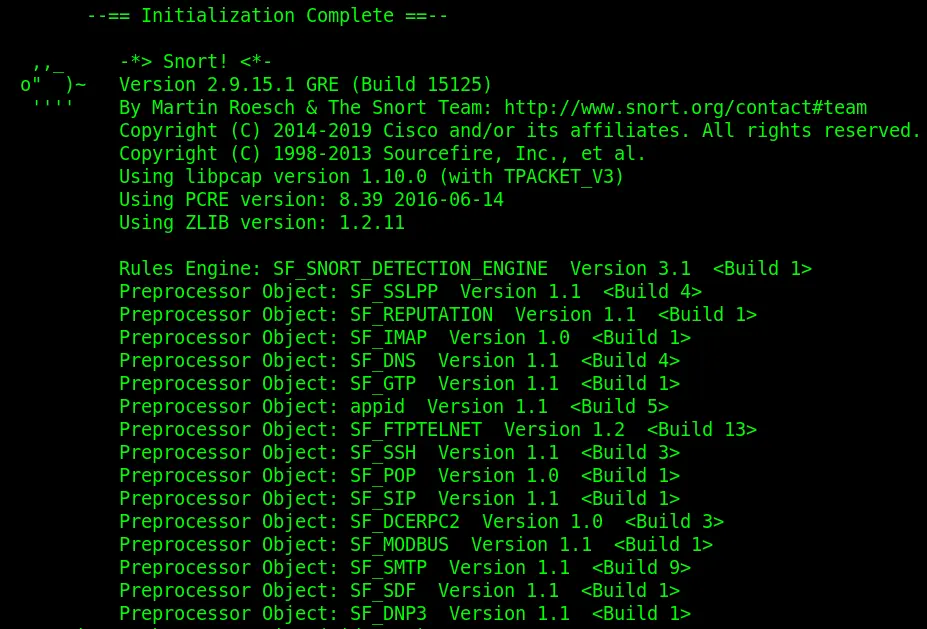本文将简单描述如何使用 scapy 来测试 snort 规则。
安装
snort 和 scapy 都可以直接 sudo apt install,不再赘述。
snort 配置
snort 默认安装在 /etc/snort 下。目录结构如下:
/etc/snort
├─ attribute_table.dtd
├─ file_magic.conf
├─ unicode.map
├─ classification.config
├─ gen-msg.map
├─ snort.conf
├─ community-sid-msg.map
├─ reference.config
├─ snort.debian.conf
├─ threshold.conf
└─ rules
├─ attack-responses.rules
├─ // many rules
└─ x11.rules
目录中有大量的配置文件,每个文件都有详细的注释,感兴趣的可以仔细阅读并个性化配置。我们目前只需要用到 snort.conf。文件夹 /rules 里面存储的是默认的规则,我们暂时用不到它们。
现在,为了方便使用,我们在 /etc/snort 下新建一个文件夹 /test,并在 /test 中新建一个名为 test.rules 的文件。我们将会利用这个文件进行简单的测试。
修改 test.rules 内容为:
alert tcp any any -> any 8080 (flags: A; msg: "TEST ALERT"; content: "I am IDS Homework I"; nocase; offset: 100; depth: 100; sid: 1000001; rev: 1;)
规则具体的含义我们会在后文讲解。
现在,打开 snort.conf,在 STEP #1 中可以看到如下语句
var RULE_PATH /etc/snort/rules
var SO_RULE_PATH /etc/snort/so_rules
var PREPROC_RULE_PATH /etc/snort/preproc_rules
我们添加一条
var TEST_RULE_PATH /etc/snort/test
将我们刚刚建立的文件夹加入路径。
现在翻到 STEP #7,这各部分引用了各种规则,我们使用 # 将它们全部注释掉。然后,加入我们自己刚刚新建的规则:
include $TEST_RULE_PATH/test.rules
保存后,snort 已经可以正常使用我们刚刚新建的规则了。
现在,我们来启动 snort。首先查看自己的网卡名称:
ifconfig
然后启动 snort:
sudo snort -A console -i ens33 -u snort -g snort -c /etc/snort/snort.conf
-A console 表明将所有的输出直接输出到控制台,方便我们测试时查看。-i ens33 表明我们使用的 interface,这里的 ens33 需要替换为你刚刚看到的网卡名称。
此时,snort 已经在正常嗅探了。

rules 编写
通常来说,每行一条 rules。rules 由以下几个部分组成:
rules
├─ Header
│ ├─ RuleType
│ └─ Five Tuple
│ ├─ Protocol
│ ├─ sip
│ ├─ dip
│ ├─ sport
│ └─ dport
└─ Options
├─ General
│ ├─ Msg
│ ├─ Reference
│ ├─ gid / sid / rev
│ ├─ Classtype
│ ├─ priority
│ └─ metadata
├─ Non-Payload
│ ├─ dsize
│ ├─ ttl
│ ├─ tos
│ └─ ……
├─ Payload
│ ├─ depth / offset / within / distance
│ ├─ decode: http / uri / sip
│ └─ ……
├─ Post-Detection
├─ flow: to_client / to_server / established
└─ flowbits: set / unset / isset / noalert
在 RuleType 中,对于 IDS,有 alert、log、pass 三种;对于 IPS,有 drop、reject、sdrop 三种。
我们举一个例子:
alert tcp 192.168.200.5 any -> $HOME_NET 8080 (msg:"ET TROJAN IRC Potential bot
update/download via ftp command"; flowbits:isset,is_proto_irc;
flow:established,to_client; content:"ftp|3a|//"; nocase; fast_pattern:only;
pcre:"/\.(upda|getfile|dl\dx|dl|download|execute)\w*\s+ftp\x3a\x2f\x2f/i";
reference:url,doc.emergingthreats.net/2011162; classtype:trojan-activity; sid:2011162;
rev:5; metadata:created_at 2010_07_30, updated_at 2019_10_07;)
在上面的 rule 中,
-
alert表明如果侦测到相应的流量,则发出警报 -
tcp表明我们嗅探的是 tcp 报文 -
192.168.200.5 any表明报文源地址为 192.168.200.5 的任意端口 -
$HOME_NET 8080表明报文目的地址为本地网络的 8080 端口 -
msg:"ET TROJAN IRC Potential bot update/download via ftp command"表明如果检测到响应流量,则警报引号中的内容 -
flowbits:isset,is_proto_irc表明设置了 irc 协议 -
flow:established,to_client表明已经建立了去往 client 的通道 -
content:"ftp|3a|//"表明要匹配的报文内容 -
nocase表明不区分大小写 -
fast_pattern:only设置了快速匹配的模式 -
pcre:"/\.(upda|getfile|dl\dx|dl|download|execute)\w*\s+ftp\x3a\x2f\x2f/i"描述了匹配的正则表达式
现在,回过来看我们之前定义的规则:
alert tcp any any -> any 8080 (flags: A; msg: "TEST ALERT"; content: "I am IDS Homework I"; nocase; offset: 100; depth: 100; sid: 1000001; rev: 1;)
其含义为:侦测 tcp 报文,报文满足目的端口为 8080、是 ACK 报文,内容含有 I am IDS Homework I,不区分大小写,内容在第 100 至 200 byte 之间。如果侦测到,则警报 TEST ALERT。
scapy 使用
sudo scapy
即可开始使用 scapy。

我们试着新建一个 IP 包:
>>> a=IP(dst="192.168.0.1")
>>> a
<IP dst=192.168.0.1 |>
同样的,我们也可以建立 Ether、TCP、ICMP 等等。
包中可以设置各个参数,我们可以这样看有哪些参数:
>>> ls(IP())
version : BitField (4 bits) = 4 (4)
ihl : BitField (4 bits) = None (None)
tos : XByteField = 0 (0)
len : ShortField = None (None)
id : ShortField = 1 (1)
flags : FlagsField (3 bits) = <Flag 0 ()> (<Flag 0 ()>)
frag : BitField (13 bits) = 0 (0)
ttl : ByteField = 64 (64)
proto : ByteEnumField = 0 (0)
chksum : XShortField = None (None)
src : SourceIPField = '127.0.0.1' (None)
dst : DestIPField = '127.0.0.1' (None)
options : PacketListField = [] ([])
我们可以使用 \ 将两个包进行嵌套。例如:
>>> Ether() / IP() / TCP()
<Ether type=IPv4 |<IP frag=0 proto=tcp |<TCP |>>>
以上均只生成了一个包,下面我们试着生成多个包。例如,对某一范围内的所有 ip 生成包:
>>> [p for p in IP(dst=Net('www.slashdot.org/30'))]
[<IP dst=204.68.111.104 |>,
<IP dst=204.68.111.105 |>,
<IP dst=204.68.111.106 |>,
<IP dst=204.68.111.107 |>]
选取多个 ttl 发包:
>>> [p for p in IP(ttl=[1,2,(7,9)])]
[<IP ttl=1 |>,
<IP ttl=2 |>,
<IP ttl=7 |>,
<IP ttl=8 |>,
<IP ttl=9 |>]
建立好包后,我们需要发送包。我们以前文建立好的 a 包为例:
>>> sendp(a,iface="ens33")
.
Sent 1 packets.
以上便是 scapy 的基础使用了。
如果我们需要测试前文编写的规则 test.rules,则可以
>>> sendp(Ether()/IP(dst="192.168.220.129")/TCP(dport=8080, flags='A') / Raw(load="11111111111111111111111111111111111111111111111111111111111111111111111111111111111111111111111111111111111111I am IDS Homework I"))
.
Sent 1 packets.
此时,snort 处会显示
[**] [1:1000001:1] TEST ALERT [**] [Priority: 0] {TCP} 192.168.18.128:20 -> 192.168.220.129:8080
说明成功探测到了流量。
有时候,我们需要实现更加复杂的功能,则可以直接编写 python 程序。例如,上面的报文发送可以这么写:
#!/usr/bin/python
#coding=utf-8
from scapy.all import *
def snortTest(dst, dport, load, iface, count):
pkt = Ether() / IP(dst=dst) / TCP(dport=dport, seq=13131342, flags='A') / Raw(load=load)
sendp(pkt, iface=iface, count=count)
dst = "192.168.220.129"
dport = 8080
load = ""
for i in range(110):
load += "1"
load += "I am IDS Homework I"
iface = "ens33"
count = 1
snortTest(dst, dport, load, iface, count)
效果是一样的。




Comments